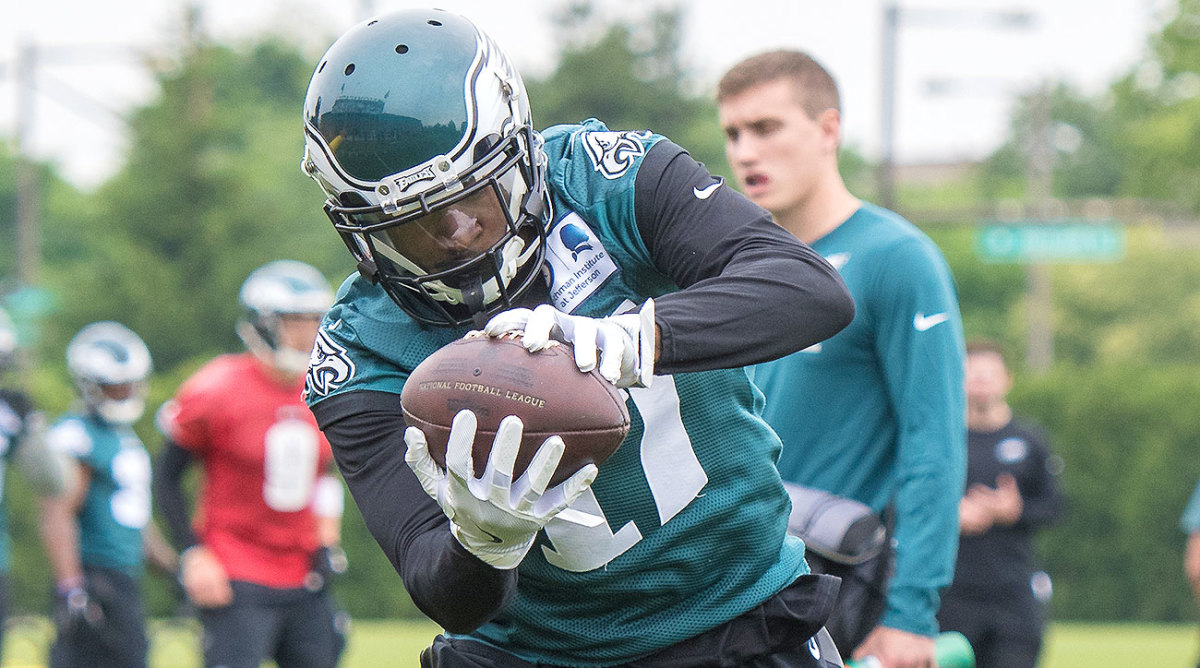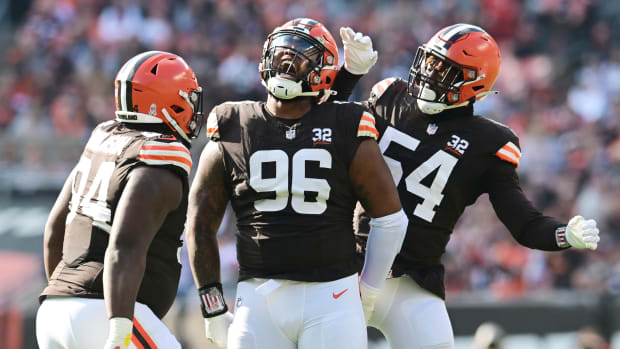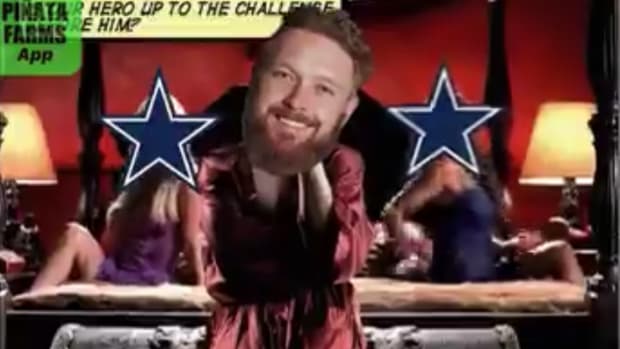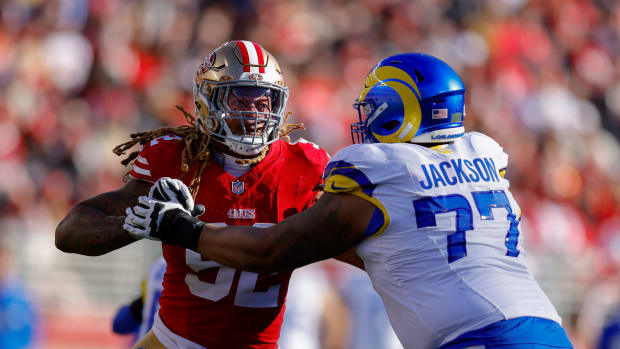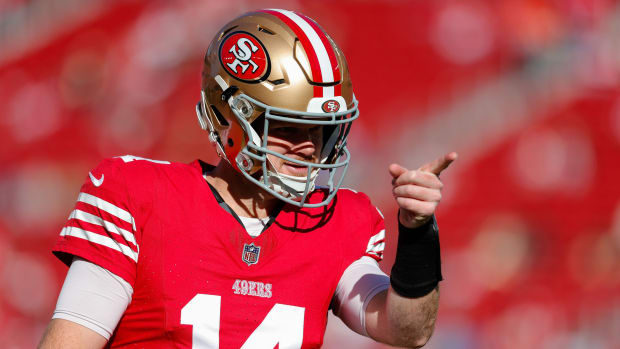Off-season report card: Philadelphia Eagles
Last Year: 7–9, fourth in NFC East
Significant Additions: WR Alshon Jeffery (FA), RB LeGarrette Blount (FA), WR Torrey Smith (FA), DE Chris Long (FA), DT Timmy Jernigan (FA), DE Derek Barnett (R1), CB Sidney Jones (R2), CB Rasul Douglas (R3), RB Donnel Pumphrey (R4), WR Mack Hollins (R4), WR Shelton Gibson (R5)
Significant Departures: DE Connor Barwin, NT Bennie Logan, CB Nolan Carroll, CB Leodis McKelvin
Perhaps the biggest name in free agency this year was Alshon Jeffery. The Eagles got him with a one-year, $9.5 million deal. Worst-case scenario: The long, strong-handed ex-Bear incurs more of the injuries and failed PED tests that hurt him in Chicago. Best-case scenario: He fixes a shoddy receiving corps that neutered Doug Pederson’s offense in 2016. The Eagles needed to do something here. Their wide receivers were so slow and undependable last season that Pederson often chose to operate out of two-tight-end sets in obvious passing situations. That’s unheard of in today’s NFL, where three-receiver sets are the norm.
Not only is Jeffery a receiver you never take off the field, he’s also one who can draw extra safety help. That will clarify the coverage reads for the team’s budding star quarterback. Carson Wentz was already stellar at identifying coverage, and with 16 games now under his belt, his classroom football IQ should translate more to the field. This will eventually lead to a more vertical passing game. Last season, to keep things manageable for their rookie QB, Pederson and his staff encouraged Wentz to get the ball out quickly. A guaranteed seven-yard completion was almost always preferable even to a very likely 20-yard completion. But make no mistake: Wentz has the arm, toughness and field vision to make those 20-yarders. He’s similar to Andrew Luck in his ability to extend plays. Jeffery makes it easier for Wentz to choose these spots.
In case there was any doubt about the futility of this receiving corps, the Eagles added three other players to it: veteran Torrey Smith (signed over from San Francisco), fourth-round pick Mack Hollins and fifth-rounder Shelton Gibson. Most likely, the only receiver from last year who will remain a regular contributor is possession slot man Jordan Matthews.
Why You Can’t Let Young QBs Learn from the Bench
Of these three newcomers, Smith will get the best crack at playing time. It’ll be interesting to see how he fits Pederson’s offense. Smith is a stiff, limited route-runner, which can be especially problematic in a system built on the timing and spacing of route combinations. However, he still has straight-line speed that defenses must honor. How much will Pederson build around that? Even if Smith isn’t getting the ball, such speed can be used to impact safeties, which frees up other targets.
The rest of Philly’s offense is relatively unchanged. Running back LeGarrette Blount is a familiar name, but with fourth-round pick Donnel Pumphrey coming aboard, and incumbents Ryan Mathews, Darren Sproles and Wendell Smallwood being more diverse players, it’ll be tough to find him snaps. Up front, the Eagles did not address left tackle, with this year’s free agent and draft classes being so weak at that position. Instead they’ll stick with Jason Peters. His 35 years of age now show, but the belief is he can grind for one more year.
On defense, the personnel has been shuffled, starting up front. Sturdy veteran Connor Barwin was released. In his stead is Chris Long, another sturdy veteran who can set the edge against the run, and first-round pick Derek Barnett, who figures to at first be a pass-rushing specialist behind Long.
At nosetackle, Bennie Logan signed with Kansas City; in his spot (sort of) is ex-Raven Timmy Jernigan. We say “sort of” because Logan was a gap-clogger who could dominate with strong east/west movement. Jernigan is more of a north/south gap-shooter. His best position is three-technique (i.e. between the guard and tackle). He and Fletcher Cox can each line up at a three-tech spot on third downs, but on first and second down, one of those two will have to align tighter inside, between the guard and center (i.e. at “nose shade”). Cox might be the best all-around three-tech in football; the guess here is Jernigan will play the nose. But can he?
Changes abound in the secondary, too. Starting corners Nolan Carroll and Leodis McKelvin were allowed to walk in free agency. (Both could be effective at times, but neither was effective all the time. McKelvin could be especially up and down.) Journeyman Patrick Robinson was signed in free agency, but the real additions were second-round pick Sidney Jones and third-round pick Rasul Douglas. They’ll be counted on to start in nickel in 2018. For Douglas, it could even be sooner. For Jones, it will be whenever his torn Achilles is healed.
Defensive coordinator Jim Schwartz believes in straightforward, fundamentally sound football. That is to say, he doesn’t riddle his scheme in complexities. Theoretically, this should make it easier for newcomers to contribute right away.
































